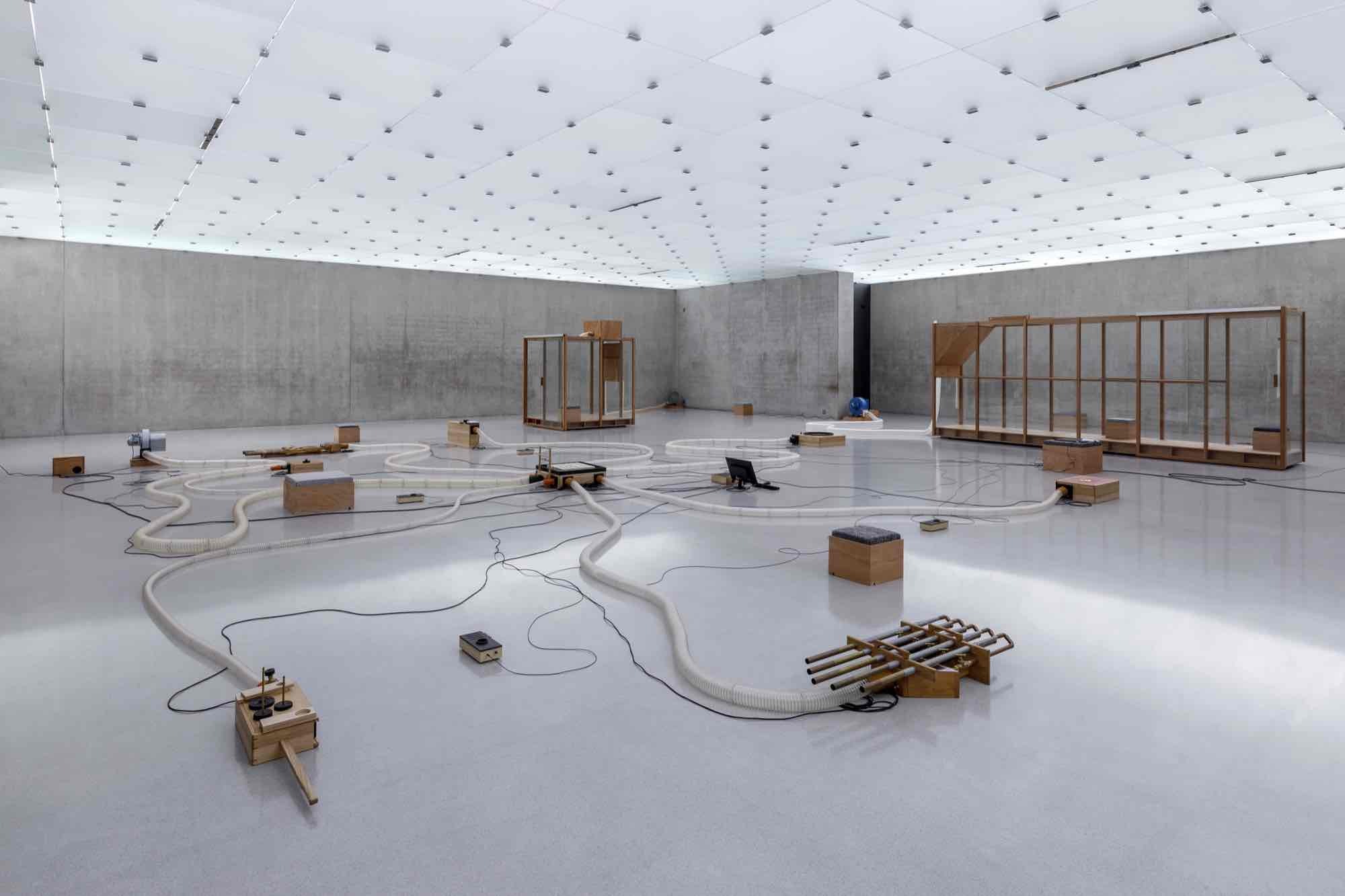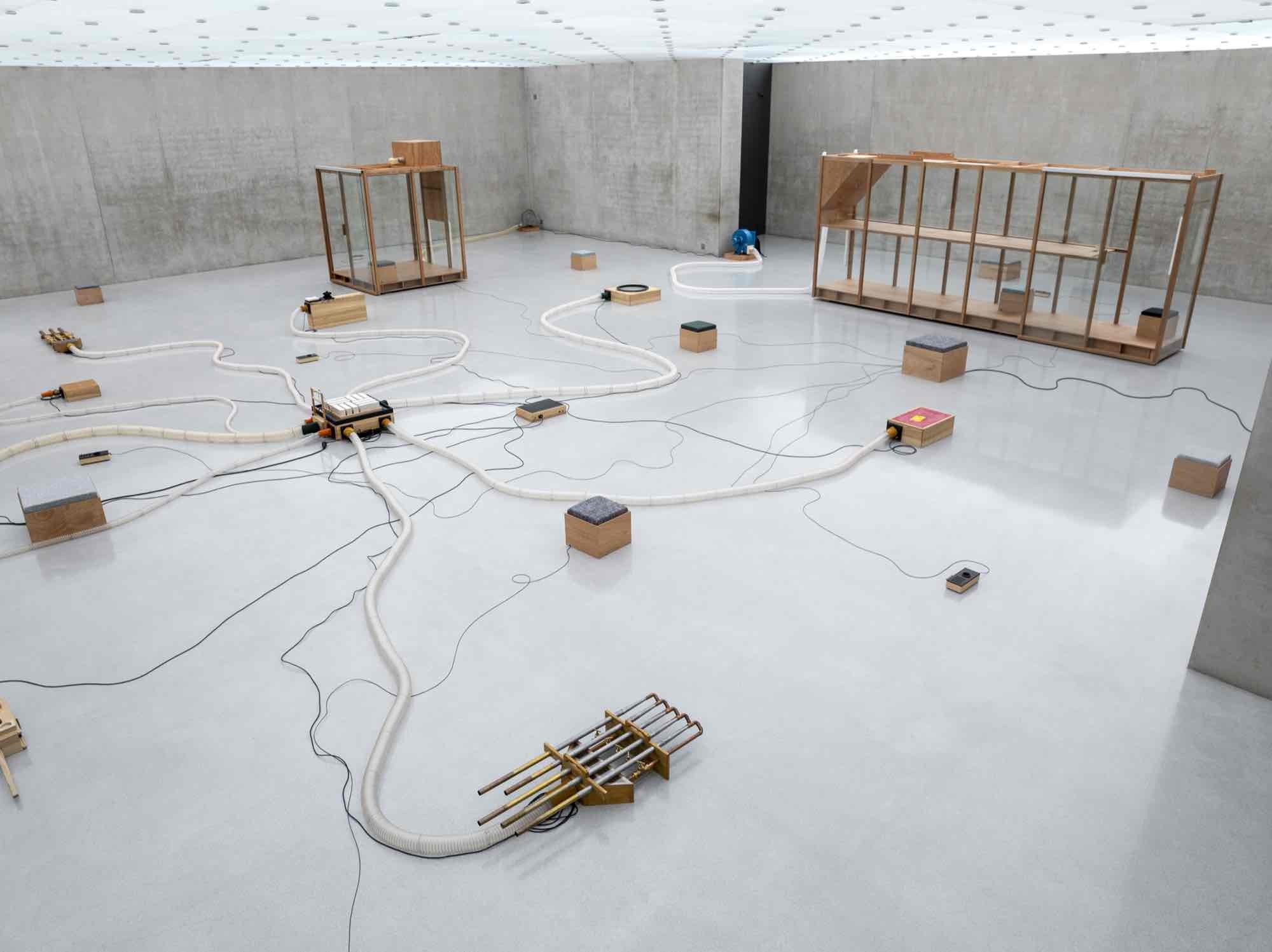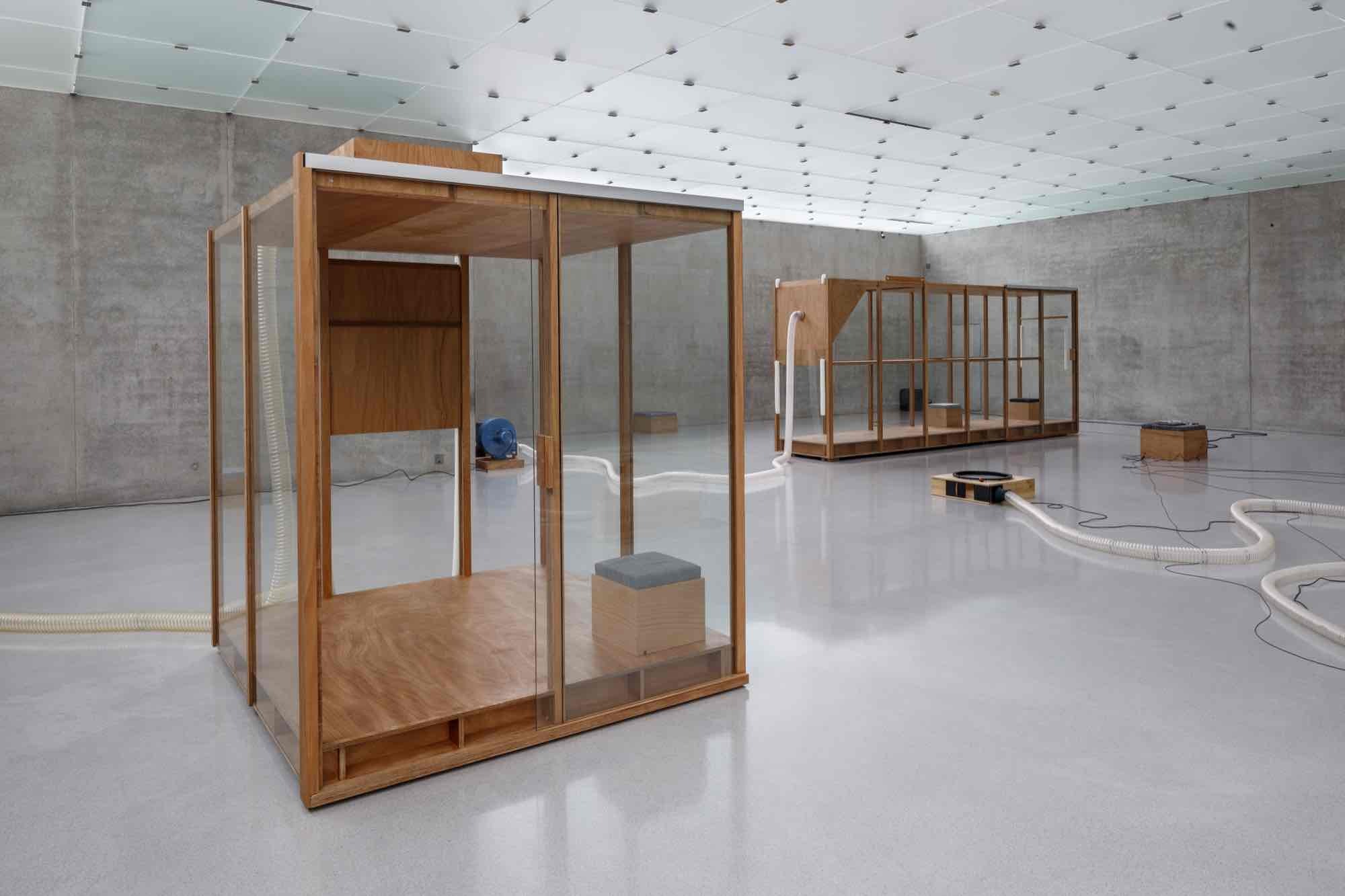Tarek Atoui
12 Oct 2024 - 12 Jan 2025

Tarek Atoui, Installation view ground floor Kunsthaus Bregenz, 2024
Photo: Markus Tretter, Courtesy of the artist © Tarek Atoui, Kunsthaus Bregenz
Photo: Markus Tretter, Courtesy of the artist © Tarek Atoui, Kunsthaus Bregenz

Tarek Atoui, Installation view ground floor Kunsthaus Bregenz, 2024
Photo: Markus Tretter, Courtesy of the artist © Tarek Atoui, Kunsthaus Bregenz
Photo: Markus Tretter, Courtesy of the artist © Tarek Atoui, Kunsthaus Bregenz

Tarek Atoui, Souffle Continu, Installation view first floor Kunsthaus Bregenz, 2024
Photo: Markus Tretter, Courtesy of the artist © Tarek Atoui, Kunsthaus Bregenz
Photo: Markus Tretter, Courtesy of the artist © Tarek Atoui, Kunsthaus Bregenz

Tarek Atoui, Souffle Continu, Installation view first floor Kunsthaus Bregenz, 2024
Photo: Markus Tretter, Courtesy of the artist © Tarek Atoui, Kunsthaus Bregenz
Photo: Markus Tretter, Courtesy of the artist © Tarek Atoui, Kunsthaus Bregenz

Tarek Atoui, Installation view first floor Kunsthaus Bregenz, 2024
Photo: Markus Tretter, Courtesy of the artist © Tarek Atoui, Kunsthaus Bregenz
Photo: Markus Tretter, Courtesy of the artist © Tarek Atoui, Kunsthaus Bregenz

Tarek Atoui, Installation view first floor Kunsthaus Bregenz, 2024
Photo: Markus Tretter, Courtesy of the artist © Tarek Atoui, Kunsthaus Bregenz
Photo: Markus Tretter, Courtesy of the artist © Tarek Atoui, Kunsthaus Bregenz

Tarek Atoui, Installation view first floor Kunsthaus Bregenz, 2024
Photo: Markus Tretter, Courtesy of the artist © Tarek Atoui, Kunsthaus Bregenz
Photo: Markus Tretter, Courtesy of the artist © Tarek Atoui, Kunsthaus Bregenz

Tarek Atoui, Souffle Continu, Organ Within, 2022
Detail view first floor Kunsthaus Bregenz, 2024
Photo: Markus Tretter, Courtesy of the artist, kurimanzutto © Tarek Atoui, Kunsthaus Bregenz
Detail view first floor Kunsthaus Bregenz, 2024
Photo: Markus Tretter, Courtesy of the artist, kurimanzutto © Tarek Atoui, Kunsthaus Bregenz

Tarek Atoui, Souffle Continu, Wind House #1, 2023
Installation view first floor Kunsthaus Bregenz, 2024
Photo: Markus Tretter, Courtesy of the artist © Tarek Atoui, Kunsthaus Bregenz
Installation view first floor Kunsthaus Bregenz, 2024
Photo: Markus Tretter, Courtesy of the artist © Tarek Atoui, Kunsthaus Bregenz

Tarek Atoui, Souffle Continu, Wind House #1, 2023
Installation view first floor Kunsthaus Bregenz, 2024
Photo: Markus Tretter, Courtesy of the artist © Tarek Atoui, Kunsthaus Bregenz
Installation view first floor Kunsthaus Bregenz, 2024
Photo: Markus Tretter, Courtesy of the artist © Tarek Atoui, Kunsthaus Bregenz
Music and sound are an integral part of the artistic program of Kunsthaus Bregenz. This is where, in 2015, Susan Philipsz played her arrangements of Hanns Eisler’s score for the film Night and Fog, and in 2021 KUB proved to be the perfect venue for the art of Anri Sala. For Peter Zumthor, music is a major inspiration for his architectural ideas. For Expo 2000 in Hannover, Zumthor, a winner of the Pritzker award who had originally wanted to be a double bass player, designed the Swiss Pavilion as a walkable and tangible sound box.
Sound, acoustic experience, and musical performance play a central role in Tarek Atoui’s work as well. Atoui is an artist and composer who works with a large number of musical devices. He experiments with electroacoustic sources and synthesizers, is involved in studies on soundscapes, and builds precisely developed musical instruments. Atoui’s inspiration is also drawn from other cultures, from sharing insights with experts, artisans, and musicians from all over the world. His art reads like a new manifestation of the Arts and Crafts movement shifted to the realm of music and of acoustic perception. In the KUB exhibition, the instruments that are to be used in various compositions are spread out in the room, and visitors stroll through a landscape of sound sources laid out on the floor. They are urged to sensitize not only their sense of hearing but also their sense of space. Kunsthaus Bregenz, with its spaciousness and acoustic echo effects, is particularly suited for this purpose.
Tarek Atoui, who emphasises mutuality and common understanding in art, rejects the traditional conventions of musical performance. At the same time, he believes in the inspirational and sensitizing quality of audio experiences. He is concerned not only with triggering aesthetic perception, but also with integrating social, political, geographical, and historical perspectives. For the specially designed accompanying educational program with workshops and creative projects, Atoui works closely together with the mediation team of the Kunsthaus Bregenz. From 24 to 26 October a series of performances featuring Tarek Atoui and international musicians will take place in the exhibition.
On the first floor the focus is on the tactile quality of the sound, vibration, and movement of the “wind instruments”. The Wind Houses link hearing, touch, and sight. These are listening and performance spaces which are at the same time huge musical instruments. Specifically for Bregenz, Atoui created Windhouse #2, a new version of his “wind gathering device”, which is activated by a powerful air current. As is the case with a flute, air is divided by a bevelled board, thus producing low sounds that resonate throughout the body and in the surrounding space.
Organ Within is a hybrid sculptural installation that combines research into church pipe organs with the sonic experiences of deaf people. It consists of a network of tubes which connect a computer with an air blower, and various organ modules which interact with each other in such a way that their sounds constantly adapt to each other.
The work on the second floor is entitled Waters’ Witness. For this ongoing work Tarek Atoui collected the sounds of various port cities such as Athens, Abu Dhabi, Singapore, Beirut, Porto, Istanbul, and Sydney. With Waters’ Witness Tarek Atoui composes a soundscape that connects distinct realities geographically and symbolically. He thus creates space for new encounters, new exchanges, and above all new immaterial connections, comparable to a port that, by definition, is located at the interface of several spheres of influence and is a measure of a city’s growth and change.
The top floor is dedicated to rain. Atoui began his project The Rain during a research trip to South Korea. He studied traditional Korean musical instruments, working together closely with local artisans and scholars of traditional culture. He expanded his set of instruments by adding ceramic resonating bodies, porcelain, and hanji, a traditional Korean paper. The work was first presented at the 2023 Gwangju Biennale.
Sound, acoustic experience, and musical performance play a central role in Tarek Atoui’s work as well. Atoui is an artist and composer who works with a large number of musical devices. He experiments with electroacoustic sources and synthesizers, is involved in studies on soundscapes, and builds precisely developed musical instruments. Atoui’s inspiration is also drawn from other cultures, from sharing insights with experts, artisans, and musicians from all over the world. His art reads like a new manifestation of the Arts and Crafts movement shifted to the realm of music and of acoustic perception. In the KUB exhibition, the instruments that are to be used in various compositions are spread out in the room, and visitors stroll through a landscape of sound sources laid out on the floor. They are urged to sensitize not only their sense of hearing but also their sense of space. Kunsthaus Bregenz, with its spaciousness and acoustic echo effects, is particularly suited for this purpose.
Tarek Atoui, who emphasises mutuality and common understanding in art, rejects the traditional conventions of musical performance. At the same time, he believes in the inspirational and sensitizing quality of audio experiences. He is concerned not only with triggering aesthetic perception, but also with integrating social, political, geographical, and historical perspectives. For the specially designed accompanying educational program with workshops and creative projects, Atoui works closely together with the mediation team of the Kunsthaus Bregenz. From 24 to 26 October a series of performances featuring Tarek Atoui and international musicians will take place in the exhibition.
On the first floor the focus is on the tactile quality of the sound, vibration, and movement of the “wind instruments”. The Wind Houses link hearing, touch, and sight. These are listening and performance spaces which are at the same time huge musical instruments. Specifically for Bregenz, Atoui created Windhouse #2, a new version of his “wind gathering device”, which is activated by a powerful air current. As is the case with a flute, air is divided by a bevelled board, thus producing low sounds that resonate throughout the body and in the surrounding space.
Organ Within is a hybrid sculptural installation that combines research into church pipe organs with the sonic experiences of deaf people. It consists of a network of tubes which connect a computer with an air blower, and various organ modules which interact with each other in such a way that their sounds constantly adapt to each other.
The work on the second floor is entitled Waters’ Witness. For this ongoing work Tarek Atoui collected the sounds of various port cities such as Athens, Abu Dhabi, Singapore, Beirut, Porto, Istanbul, and Sydney. With Waters’ Witness Tarek Atoui composes a soundscape that connects distinct realities geographically and symbolically. He thus creates space for new encounters, new exchanges, and above all new immaterial connections, comparable to a port that, by definition, is located at the interface of several spheres of influence and is a measure of a city’s growth and change.
The top floor is dedicated to rain. Atoui began his project The Rain during a research trip to South Korea. He studied traditional Korean musical instruments, working together closely with local artisans and scholars of traditional culture. He expanded his set of instruments by adding ceramic resonating bodies, porcelain, and hanji, a traditional Korean paper. The work was first presented at the 2023 Gwangju Biennale.
